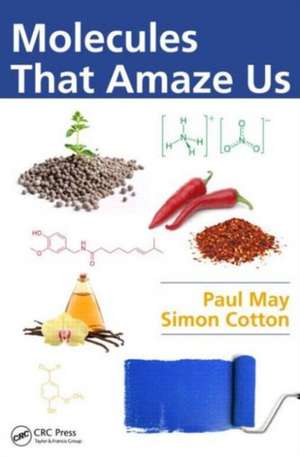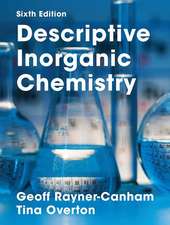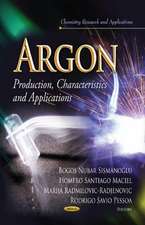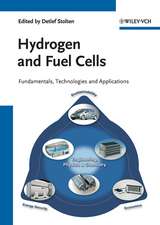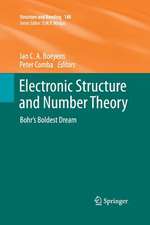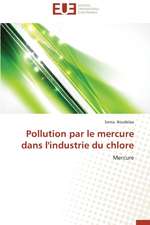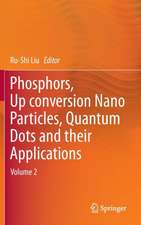Molecules That Amaze Us
Autor Paul Mayen Limba Engleză Paperback – 23 oct 2014
—From the Foreword by Dr. Eric Scerri, UCLA, Los Angeles, website: www.ericscerri.com, Author of ‘The Periodic Table, Its Story and Its Significance’ and several other books on the elements and the periodic table.
The world is composed of molecules. Some are synthetic while many others are products of nature. Molecules That Amaze Us presents the stories behind many of the most famous and infamous molecules that make up our modern world. Examples include the molecule responsible for the spicy heat in chilies (capsaicin), the world’s first synthetic painkiller (aspirin), the pigment responsible for the color of autumn leaves (carotene), the explosive in dynamite (nitroglycerine), the antimalarial drug (quinine), the drug known as "speed" (methamphetamine), and many others.
Other molecules discussed include caffeine, adrenaline, cholesterol, cocaine, digitalis, dopamine, glucose, insulin, methane, nicotine, oxytocin, penicillin, carbon dioxide, limonene, and testosterone. In all, the book includes 67 sections, each describing a different molecule, what it does, how it is made, and why it is so interesting.
Written by experts in the field, the book is accessible and easy to read. It includes amusing anecdotes, historical curiosities, and entertaining facts about each molecule, thereby balancing educational content with entertainment. The book is heavily illustrated with relevant photographs, images, and cartoons—the aim being both to educate and entertain.
| Toate formatele și edițiile | Preț | Express |
|---|---|---|
| Paperback (1) | 370.21 lei 6-8 săpt. | |
| CRC Press – 23 oct 2014 | 370.21 lei 6-8 săpt. | |
| Hardback (1) | 1061.94 lei 6-8 săpt. | |
| CRC Press – 11 sep 2017 | 1061.94 lei 6-8 săpt. |
Preț: 370.21 lei
Preț vechi: 464.37 lei
-20% Nou
Puncte Express: 555
Preț estimativ în valută:
70.84€ • 73.96$ • 58.63£
70.84€ • 73.96$ • 58.63£
Carte tipărită la comandă
Livrare economică 04-18 aprilie
Preluare comenzi: 021 569.72.76
Specificații
ISBN-13: 9781466589605
ISBN-10: 1466589604
Pagini: 742
Ilustrații: 654 colour illustrations, 4 black & white tables
Dimensiuni: 156 x 234 x 30 mm
Greutate: 1.38 kg
Ediția:1
Editura: CRC Press
Colecția CRC Press
Locul publicării:Boca Raton, United States
ISBN-10: 1466589604
Pagini: 742
Ilustrații: 654 colour illustrations, 4 black & white tables
Dimensiuni: 156 x 234 x 30 mm
Greutate: 1.38 kg
Ediția:1
Editura: CRC Press
Colecția CRC Press
Locul publicării:Boca Raton, United States
Cuprins
Adenosine Triphosphate (ATP). Adrenaline/Epinephrine (Noradrenaline/Norepinephrine). Ammonium Nitrate. Artemisinin. Aspirin. Caffeine. Capsaicin. Carbon Dioxide. Carotene. Chlorophyll. Cholesterol. Cisplatin. Cocaine. DEET. CF2Cl2. DDT. Digitalis. Dimethylmercury. Dimethylsulfide. Dopamine. Epibatidine. Estradiol. Glucose. Glycerol. Heavy Water. Heme. Hexenal. Hydrogen Peroxide. Insulin. Kisspeptin. Lauric Acid. Limonene. Linoleic Acid. LSD. Medroxyprogesterone Acetate. Methamphetamine. Methane. 2-Methylundecanal. Monosodium Glutamate. Morphine, Codeine and Heroin. Nandrolone. Nicotine. Nitrous Oxide. 1-Octen-3-ol. Oxygen (and Ozone). Oxytocin. Paracetamol (Acetaminophen). Penicillins. Prostanoic Acid and Prostaglandins. Psilocybin and Mescaline. Quinine. Sodium Hypochlorite. Serotonin. Skatole. Sucrose. Sweaty' Acid, (E)-3-Methyl-2-Hexenoic Acid. Taxol (Paclitaxel). Testosterone. Tetrahydrocannabinol (THC). Tetrahydrogestrinone (THG). Tetrodotoxin. Thujone. Trimethylamine. TNT. Vancomycin. VX. Water. Bibliography. Index.
Recenzii
"This fascinating book presents intriguing facts about a huge range of compounds. ... The information is provided in bite-sized chunks as the answers to questions. This makes it easy to read, as you don't have to start at the beginning. You can dip in wherever you like and you are sure to find something intriguing or (as the title says) amazing. ... I will leave you to browse and discover all the nuggets of fascinating chemistry - you will be amazed."
—Anne Hodgson, from Chemistry Review, February 2016
"... a wonderful and easy-to-read book that would be of interest to a wide audience, ranging from chemistry faculty to high school teachers to anyone who is simply interested in learning about a variety of molecules that have impacted the human condition. ... The examples presented in this book provide a wealth of educational material that relate both molecules, and many of the principles of chemistry, to a wide variety of contextual situations of interest to the general public. ... Each chapter’s information is presented through a storyline of multiple sections that are introduced with a question that is followed by an answer. ... Not only do the authors use this Q&A style to chunk the material in an easily understood manner, but they are also able to use it to present the underlying concepts of complicated multifaceted topics in a neutral manner. In its entirety, Molecules That Amaze Us is a trove of facts and exemplars for a wide variety of chemicals that could be useful to many members of the JCE readership. ... The Q&A format with extensive use of images allows the novice to follow the material without getting bogged down in the details. ... I think educators would also find the Q&A format of this book to have some advantages over the more traditional encyclopedia-style format of presenting information, in that they can navigate the material based on the questions, and not statements of facts. That is, getting students to think is more than stating some basic facts, and with this book, you can quickly choose a chemical, browse through a bunch of questions, and potentially find concepts that would interest your students."
—Robert E. Belford, Department of Chemistry, University of Arkansas at Little Rock, USA, from Journal of Chemical Education, January 25, 2016
"Molecules are everywhere, both inside us and out, but they are more than just common. The ones you will find in Molecules that Amaze Us are incredible. The stories behind many molecules in this book can provide teachers with dozens of fantastic examples on a multitude of topics—or just catch students’ attention—in chemistry and biology lessons. Molecules that Amaze Us is an engaging book that provides a balanced mix of entertainment and education."
—Jose Viosca, in Science and School
"In 67 chapters, the authors describe more than that many chemicals, arranged in alphabetical order from ATP to water (the most amazing chemical of all). Even experienced chemists will find much new information here. Recommended for all readers, high school age and up."
—R. E. Buntrock, formerly University of Maine, in CHOICE
"The authors strike a good mix in their use of historical content and pop culture references, using famous names to illustrate the compounds’ origin and history. For chemistry-savvy readers…the book is an enjoyable, easy-to-digest collection of fascinating molecules to dip in and out of."
—Katrina Krämer, in Education in Chemistry
"This is truly a wonderful book… Molecules that amaze us is a treasure trove of chemistry that can be read by anyone.
May and Cotton write in an easy style and with humour, and while I knew a lot about the molecules within its pages, for almost every one I came across pieces of information, which had me saying ‘I didn’t know that’. Save up and buy yourself a copy."
—John Emsley, in Popular Science, April 2016.
—Anne Hodgson, from Chemistry Review, February 2016
"... a wonderful and easy-to-read book that would be of interest to a wide audience, ranging from chemistry faculty to high school teachers to anyone who is simply interested in learning about a variety of molecules that have impacted the human condition. ... The examples presented in this book provide a wealth of educational material that relate both molecules, and many of the principles of chemistry, to a wide variety of contextual situations of interest to the general public. ... Each chapter’s information is presented through a storyline of multiple sections that are introduced with a question that is followed by an answer. ... Not only do the authors use this Q&A style to chunk the material in an easily understood manner, but they are also able to use it to present the underlying concepts of complicated multifaceted topics in a neutral manner. In its entirety, Molecules That Amaze Us is a trove of facts and exemplars for a wide variety of chemicals that could be useful to many members of the JCE readership. ... The Q&A format with extensive use of images allows the novice to follow the material without getting bogged down in the details. ... I think educators would also find the Q&A format of this book to have some advantages over the more traditional encyclopedia-style format of presenting information, in that they can navigate the material based on the questions, and not statements of facts. That is, getting students to think is more than stating some basic facts, and with this book, you can quickly choose a chemical, browse through a bunch of questions, and potentially find concepts that would interest your students."
—Robert E. Belford, Department of Chemistry, University of Arkansas at Little Rock, USA, from Journal of Chemical Education, January 25, 2016
"Molecules are everywhere, both inside us and out, but they are more than just common. The ones you will find in Molecules that Amaze Us are incredible. The stories behind many molecules in this book can provide teachers with dozens of fantastic examples on a multitude of topics—or just catch students’ attention—in chemistry and biology lessons. Molecules that Amaze Us is an engaging book that provides a balanced mix of entertainment and education."
—Jose Viosca, in Science and School
"In 67 chapters, the authors describe more than that many chemicals, arranged in alphabetical order from ATP to water (the most amazing chemical of all). Even experienced chemists will find much new information here. Recommended for all readers, high school age and up."
—R. E. Buntrock, formerly University of Maine, in CHOICE
"The authors strike a good mix in their use of historical content and pop culture references, using famous names to illustrate the compounds’ origin and history. For chemistry-savvy readers…the book is an enjoyable, easy-to-digest collection of fascinating molecules to dip in and out of."
—Katrina Krämer, in Education in Chemistry
"This is truly a wonderful book… Molecules that amaze us is a treasure trove of chemistry that can be read by anyone.
May and Cotton write in an easy style and with humour, and while I knew a lot about the molecules within its pages, for almost every one I came across pieces of information, which had me saying ‘I didn’t know that’. Save up and buy yourself a copy."
—John Emsley, in Popular Science, April 2016.
Notă biografică
Paul May is a professor of physical chemistry at the University of Bristol, where he obtained his PhD. He leads a research group that studies the fabrication of thin films of artificial diamond. He has been awarded both a Ramsay Memorial Fellowship and a Royal Society University Fellowship. He also received the RSC Higher Education teaching award for innovative use of IT in chemistry teaching. He has written nearly 200 scientific articles and currently maintains the Molecule of the Month website.Simon Cotton is an honorary senior lecturer in the School of Chemistry at the University of Birmingham, UK. Dr. Cotton obtained his BSc and PhD at Imperial College London. His research focuses on the chemistry of transition metals, particularly iron and cobalt, as well as scandium and the lanthanides. Dr. Cotton has published various peer-reviewed articles and five books on the chemistry of the d- and f-block elements. He has written a column titled Soundbite Molecules for the magazine Education in Chemistry, and dozens of Chemistry in its Element podcasts for the RSC's Chemistry World website. In 2005 he shared the Royal Society of Chemistry Schools Education Award. His book Every Molecule Tells a Story is also published by CRC Press.
Descriere
This book presents an interesting, informative, and fun description of the molecules that make up modern life, and how they impact upon all of us. It contains approximately 100 sections, each describing a different molecule and typically what it does, how it’s made, and what’s so interesting about it. Examples include capsaicin (the molecule responsible for the spicy heat of chillis), DEET (the insect repellent), Kevlar® (the material for bullet-proof vests), taurine (the stimulant in Red Bull), nitroglycerine (the explosive in dynamite), and many others.
